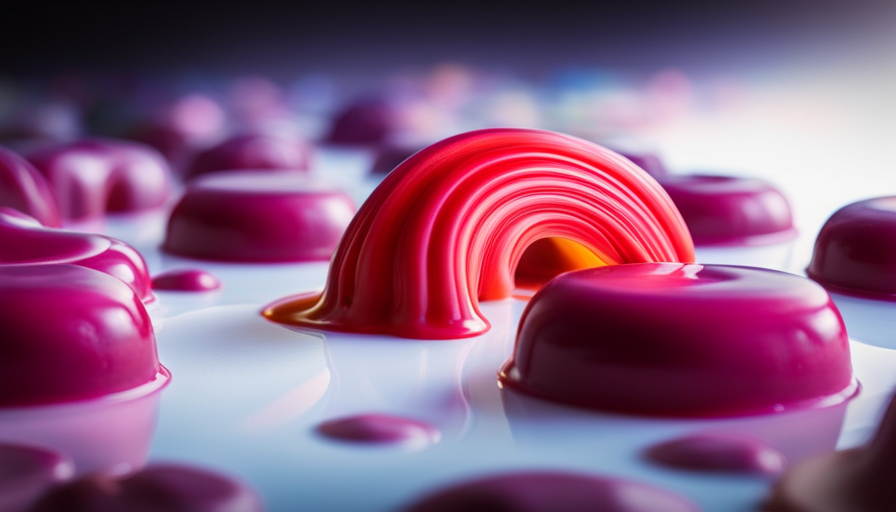Did you know that every year, candles are responsible for over 15,000 house fires? This shocking statistic highlights the importance of knowing the proper way to extinguish a candle.
In this informative article, I will guide you through the various methods of safely putting out a candle flame. Whether you’re using a candle for ambiance, relaxation, or celebration, it’s crucial to follow proper safety measures to prevent accidents and protect your home.
From using a candle snuffer to blowing out the flame, from dipping the wick into the wax to using sand or baking soda, I will provide you with step-by-step instructions on the best techniques for extinguishing a candle.
Additionally, I will emphasize the importance of never leaving a burning candle unattended and practicing proper candle safety measures.
So, let’s dive in and learn how to safely and effectively extinguish a candle flame.
Key Takeaways
- Properly extinguishing a candle is crucial to prevent home fires and ensure safety.
- There are various methods to safely put out a candle flame, such as using a candle snuffer, blowing it out from a safe distance, using a lid or cover, or dipping the wick into melted wax.
- It is important to assess the environment and remove potential hazards, create a fire safety plan, and know emergency exits in case of any accidents or emergencies.
- Mistakes to avoid when extinguishing a candle include blowing on it, smothering it with a jar or glass, or using water, as these can lead to accidents or damage.
Assess the Environment and Ensure Safety
Assess the area around you and make sure it’s safe before you can extinguish the candle. When it comes to fire safety, it’s crucial to be proactive and take necessary precautions.
Start by assessing the risks in the environment. Are there any flammable materials nearby? Are there any loose papers or curtains that could catch fire easily? Remove any potential hazards that may pose a threat.
It’s also important to create a fire safety plan. Identify the nearest fire extinguisher and make sure it’s easily accessible. Familiarize yourself with the emergency exits and escape routes. Ensure that smoke alarms are installed and functioning properly. By having a well-prepared plan, you can respond effectively in case of an emergency.
Now that you have assessed the environment and ensured safety, it’s time to use a candle snuffer. This tool is specifically designed to extinguish candles without causing any mess or splattering hot wax. By gently placing the snuffer over the flame, the lack of oxygen will smother it, and the candle will be extinguished. Remember to wait until the snuffer is cool before storing it away.
Use a Candle Snuffer
To safely put out a flickering flame, reach for a candle snuffer, the magician’s wand of candle care. This handy tool not only adds a touch of elegance to the extinguishing process but also ensures a clean and safe end to your candle-lit ambiance.
Here are four reasons why using a candle snuffer is the preferred method:
-
Snuffing technique: The candle snuffer allows you to gently press the snuffer cap onto the flame, cutting off the oxygen supply and extinguishing the fire without any risk of splattering wax.
-
Safety first: Unlike blowing out a candle, which can cause hot embers to fly or even ignite nearby objects, using a snuffer eliminates this risk, making it a safer option.
-
Minimal smoke: Snuffing a candle produces less smoke compared to blowing it out, reducing the chances of setting off smoke detectors or irritating sensitive individuals.
-
Preserves the wick: By snuffing the flame instead of blowing it out, you prevent the wick from being damaged or displaced, ensuring a longer lifespan for your candle.
Now that you know the benefits of using a candle snuffer, let’s explore another method to extinguish the flame: blowing it out.
Blow Out the Flame
Put on a show and blow out the flame like a birthday candle on your cake. It may seem like a simple task, but there are alternative methods to ensure candle safety precautions are followed.
When blowing out a candle, it’s important to remember a few key points. First, make sure to position yourself at a safe distance, away from any potential hazards. This will prevent any accidental contact with the flame or hot wax.
Additionally, consider using a candle snuffer as an alternative method. This tool allows you to extinguish the flame without blowing, reducing the risk of spreading hot wax or accidentally igniting nearby objects. However, if a candle snuffer isn’t available, blowing out the flame can be done safely by blowing from a distance, aiming to extinguish the flame in one steady breath. Remember to watch out for any loose clothing or flammable materials nearby.
To further ensure candle safety, always remember to use a lid or cover to extinguish the flame, which will be discussed in the subsequent section.
Use a Lid or Cover
Using a lid or cover is a simple yet effective way to safely snuff out the flame on a candle, reducing the risk of accidents and potential fires. Did you know that according to the National Fire Protection Association, candles caused an estimated 7,610 home fires in the United States in 2019 alone? It’s crucial to take precautions when extinguishing candles, and using a lid or cover is a reliable method.
Here are a couple of reasons why you should consider this technique:
-
Convenience: Using a lid or cover is incredibly convenient, especially if you have one specifically designed for candles. You can simply place the lid over the top of the candle, allowing the lack of oxygen to extinguish the flame.
-
Safety: The lid or cover method is one of the safest ways to put out a candle. By suffocating the flame, you minimize the risk of spreading embers or hot wax, which could potentially ignite nearby objects.
Remember, there are various methods to safely extinguish a candle, and another effective technique is to dip the wick into the wax. By doing this, you suffocate the flame and prevent any residual smoke or smoldering.
Dip the Wick into the Wax
By dipping the wick into the melted wax, you’ll experience a satisfying sizzle as the flame is snuffed out, ensuring a safe end to your candle’s glow. This method is one of the alternative methods to extinguish a candle and can be quite effective. However, it’s important to be cautious and avoid common mistakes that could lead to accidents.
To help you better understand the process, let’s take a look at this table:
| Common Mistakes | Why You Should Avoid Them |
|---|---|
| Blowing out the flame | Can cause hot wax to splatter or reignite the flame. |
| Smothering the flame with a jar or glass | May cause the glass to crack or shatter due to heat. |
| Using water | Can lead to splattering hot wax and potential damage to the candle. |
By dipping the wick into the wax, you eliminate the risk of splattering hot wax and reigniting the flame. It’s a safer alternative to blowing out the candle or smothering it with a jar or glass. However, there is another method you can use to extinguish the flame: using water.
Transitioning to the next section, we’ll explore how water can be used to safely extinguish a candle flame without any risk of hot wax splattering.
Use Water to Extinguish the Flame
Transitioning to the next section, let’s dive into how water can work its magic to safely snuff out the fiery dance of a candle’s flame. When it comes to extinguishing a candle, using water is one of the alternative methods you can employ. However, it’s important to exercise caution and follow certain safety precautions.
Water can be an effective way to put out a candle flame because it deprives the fire of oxygen, one of the three elements it needs to sustain itself. To use water, carefully pour a small amount onto the flame, making sure not to splash or spill it onto surrounding surfaces. It’s crucial to avoid using too much water, as this can cause the candle to become damaged, or worse, shatter due to the sudden temperature change. Always remember to approach this method with care.
Transitioning to the subsequent section about using sand or baking soda, these alternatives can also be effective in extinguishing a candle flame.
Use Sand or Baking Soda
One effective method for putting out a flame involves the use of sand or baking soda. When a fire breaks out and water is not readily available or suitable, sand or baking soda can be a viable alternative. These substances work by smothering the flame, cutting off its oxygen supply. Sand and baking soda are non-conductive, making them safe to use on electrical fires. They are also non-toxic, reducing the risk of harmful chemical reactions.
Using sand or baking soda to extinguish a flame is relatively straightforward. Simply pour the substance directly onto the base of the fire, ensuring that you cover the entire area. The sand or baking soda will quickly smother the flames, preventing them from spreading further. However, it is important to note that while sand and baking soda are effective for small fires, they may not be sufficient for larger or more intense fires. In such cases, it is recommended to use a fire blanket or fire extinguisher.
Using sand or baking soda as a fire extinguishing method provides a quick and efficient solution in certain situations. However, it is essential to consider the potential risks and limitations of these substances. They may not be suitable for all types of fires, and using them requires caution and proper knowledge. In the next section, we will discuss the use of a fire blanket or fire extinguisher, which provides an alternative approach for extinguishing flames.
Use a Fire Blanket or Fire Extinguisher
To effectively address the situation at hand, grab a fire blanket or fire extinguisher and take control of the flames. When faced with a candle that’s gotten out of control, it’s crucial to act swiftly and decisively.
A fire blanket is a handy tool that can quickly smother the flames, cutting off their oxygen supply and extinguishing the fire. Simply grab the fire blanket, approach the candle cautiously, and gently place the blanket over the flame, ensuring that it’s completely covered. This method is especially useful when dealing with small fires or when you need to protect yourself from the heat.
Alternatively, a fire extinguisher can also be used to put out a candle fire. Aim the extinguisher at the base of the flame and squeeze the handle to release the extinguishing agent. Remember to stand at a safe distance and aim for the root of the fire to effectively extinguish it. Fire extinguishers are a valuable tool in emergency situations and should be kept in easily accessible locations in your home.
Now, moving on to the next important topic, it’s crucial to never leave a burning candle unattended.
Never Leave a Burning Candle Unattended
Leaving a burning candle alone can lead to potentially dangerous consequences that could easily be prevented. It is crucial to prioritize candle safety and practice fire prevention measures at all times. Neglecting to do so can result in devastating fires and harm to both property and lives. To emphasize the importance of this topic, let’s take a look at the following table that highlights the potential risks associated with leaving a burning candle unattended:
| Risk | Consequence | Prevention |
|---|---|---|
| Fire hazard | Increased chance of a fire starting | Never leave a burning candle unsupervised |
| Burns | Injuries to individuals or pets | Keep candles out of reach and away from flammable objects |
| Property damage | Destruction of personal belongings | Place candles on stable surfaces and away from curtains or other combustible materials |
| Poisoning | Ingestion of melted wax or toxic fumes | Keep candles in safe containers and away from children and pets |
| Gas leaks | Ignition of gas leaks due to the candle flame | Avoid placing candles near gas appliances or leaks |
To ensure candle safety and prevent any mishaps, it is essential to practice proper candle safety measures. This includes never leaving a burning candle unattended, as well as following other recommended precautions such as keeping candles away from drafts, using candle holders that can catch dripping wax, and trimming the wick to avoid excessive flame height. By being diligent and responsible in our approach to candle safety, we can minimize the risk of accidents and protect ourselves and our surroundings from potential harm.
Practice Proper Candle Safety Measures
Ensure your home is a safe and secure environment by implementing proper candle safety measures. Here are some important discussion ideas to further promote candle safety:
-
Candle safety precautions:
- Always keep burning candles within sight and never leave them unattended.
- Place candles on a stable and heat-resistant surface, away from flammable objects.
- Keep candles out of reach of children and pets.
- Avoid placing candles near curtains, bedding, or other materials that can easily catch fire.
-
Proper storage and disposal of candles:
- Store candles in a cool, dry place, away from direct sunlight and heat sources.
- Keep candles in their original packaging or cover them to protect them from dust and debris.
- When disposing of candles, ensure they are completely extinguished and cool before discarding them.
- Consider recycling or repurposing candle containers to minimize waste.
By following these safety precautions and proper storage and disposal methods, you can enjoy the beauty and ambiance of candles while minimizing the risk of accidents or fires. Remember, candle safety is everyone’s responsibility, and taking these measures will help create a safer environment for you and your loved ones.
Frequently Asked Questions
What are some common safety hazards associated with burning candles?
Candle burning safety hazards should never be taken lightly. It’s important to be aware of the potential dangers associated with burning candles. Some common safety hazards include fire, burns, and accidental tipping.
To prevent these hazards, it’s crucial to take precautions when burning candles. Always keep candles away from flammable objects and never leave them unattended. Use sturdy candle holders. Additionally, make sure that candles are extinguished before leaving a room or going to bed to minimize the risk of accidents.
Can I use any type of lid or cover to extinguish a candle flame?
Using a lid or cover to extinguish a candle flame is not recommended as it can affect the wax. There are different types of candle extinguishers available that are specifically designed for this purpose. These extinguishers work by cutting off the oxygen supply to the flame, ensuring a safe and efficient extinguishment. It’s important to use the appropriate tools to avoid any accidents and maintain the longevity of your candles.
Is it safe to dip a candle wick into the wax to put out the flame?
Is it safe to dip a candle wick into the wax to put out the flame? Absolutely not! Doing so can lead to a dangerous situation, as the flame could reignite the wax, causing a larger fire. It’s vital to use alternative methods to extinguish a candle, such as using a candle snuffer or blowing it out gently. These methods ensure your safety and prevent any potential accidents.
How do I properly use water to extinguish a candle flame?
Using water to extinguish a candle flame can be dangerous and should be avoided. Water can cause the hot wax to splatter, increasing the risk of burns or spreading the fire. Instead, it’s recommended to use a candle snuffer or carefully blow out the flame.
Always ensure the candle is completely extinguished before leaving it unattended. Safety should be the top priority when dealing with candles to prevent accidents and potential fire hazards.
Are there any specific safety precautions I should take when using sand or baking soda to extinguish a candle flame?
When it comes to using sand or baking soda to put out a candle flame, there are a few safety precautions you should keep in mind. While both can be effective, it’s important to note that sand may not completely smother the flame, leaving a potential risk of re-ignition.
Baking soda, on the other hand, can produce a small amount of smoke when coming into contact with the flame. Therefore, it’s crucial to exercise caution and ensure proper ventilation when using either method.
Conclusion
In conclusion, extinguishing a candle requires careful attention and adherence to safety measures. By assessing the environment and using proper tools like a candle snuffer or lid, one can safely put out the flame.
Additionally, options like dipping the wick in wax or using sand or baking soda can effectively extinguish the candle.
It’s crucial to never leave a burning candle unattended and to practice proper candle safety measures. Remember, when it comes to candles, safety should always be the guiding light.
















